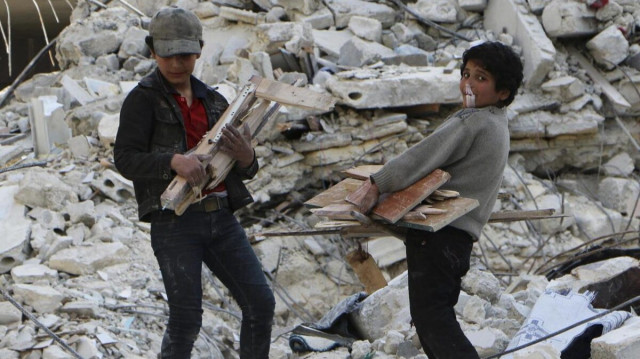
UN Children's Agency says in December alone, 116 children were killed or injured by unexploded ordnance, and there were 422,000 incidents overall in past 9 years
The UN Children's Agency (UNICEF) said on Tuesday that Syrian children continue to suffer the brutal impact of unexploded ordnance (UXO) at an alarming rate, noting that in December alone, it received reports of 116 children killed or injured by UXO, an average of nearly four a day.
"Over the past 9 years, at least 422,000 incidents involving UXO were reported in 14 Governorates across the country, with half estimated to have ended in tragic child casualties. Across Syria, children face this lurking, often invisible, and extremely deadly threat," UNICEF Communication Manager Ricardo Pires told a UN press conference via video link.
"In December of last year alone, UNICEF received reports of 116 children killed or injured by UXO, an average of nearly four per day. This is believed to be an underestimate given the fluidity of the humanitarian situation on the ground," Pires said.
Pires said that renewed displacement only worsens the danger, explaining that since Nov. 27, 2024, more than a quarter of a million children have been forced to flee their homes due to escalating conflict.
- Constant peril
"For these children and those trying to return to their original areas, the peril of UXO is constant and unavoidable," the UNICEF official said.
"As reconstruction efforts continue to be discussed, and the international community prepares to help Syria pave a new path for children, it is imperative that immediate investment takes place to ensure the ground is safe and clear of explosives," Pires said.
More than a decade of devastating conflict has left communities across Syria littered with deadly remnants of war, including an estimated 324,000 pieces of unexploded ordnance scattered across the country.
"This danger affects approximately 5 million children living in areas contaminated with UXO and landmines, which have become the leading cause of child casualties in Syria. Every step they take carries the risk of an unimaginable tragedy," Pires said.
He cited the case of 12-year-old Abdul, whom he met on the outskirts of Hama.
On Dec. 18, he was playing football with friends in a field behind his house when one of them stepped on something shiny on the ground.
"What followed was a blast that killed 15-year-old Mohamed, Abdul's cousin, and injured Abdul and his 10-year-old brother, who are now recovering from multiple fractures to their legs and arms. They can no longer walk without help. Both are deeply traumatized," said Pires.
"Their stories are far too common."
He recalled how Abdul's mother had cried when trying to recount the trauma and mentioned that the day before, another three children died after bringing a grenade into their homes, found in a playground, without knowing of the deadly impact it could have.
"Even if children survive these blasts, the struggle doesn't end. Life-changing injuries and disabilities often mean they cannot return to school or might find it harder to access proper healthcare. They face a new kind of war—against isolation, stigma, and limited opportunity," rued Pires.
He said there must be a much stronger push for increased humanitarian demining efforts to remove the deadly remnants of war and make communities safe again.
“Syria cannot move past this horrific war if children remain at risk of walking outside their doors and being blown up by explosives,” he added.
Hello, the comments you share on our site are a valuable resource for other users. Please respect other users and different opinions. Do not use rude, offensive, derogatory, or discriminatory language.
The floor is all yours.








